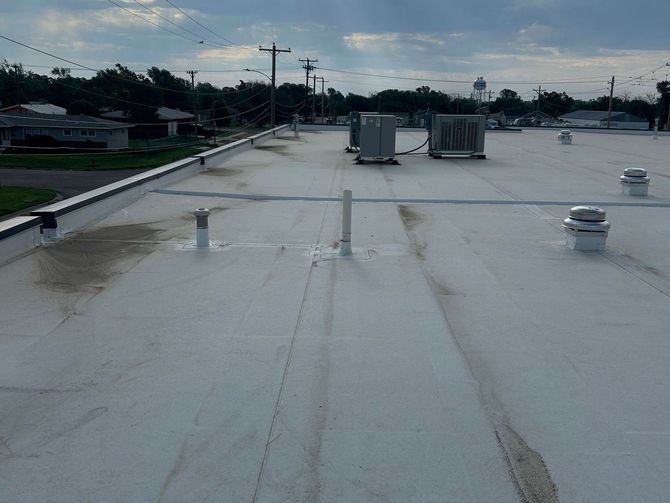Flat roofs have gained popularity in recent years for commercial properties due to their numerous advantages, such as cost savings, low-maintenance needs, and versatility. This article highlights why flat roofs are a smart investment for your commercial building, offering long-term savings and functionality.
Advantages of Flat Roofs for Commercial Buildings
Flat roofs offer significant advantages for commercial buildings, including easier installation. Since they are quicker to install than pitched roofs, flat roofs help reduce labor costs and installation time, making them a practical and efficient choice for commercial properties.
Flat roofs allow you to make the most of your available space. Since the roof is flat, it can be used for other functional purposes, including the installation of HVAC units, solar panels, or even creating a rooftop garden. This is particularly beneficial for commercial buildings in space-constrained urban areas.
Materials Used in Flat Roofing: EPDM, TPO, and PVC
Flat roofs are made from a range of materials, each offering specific advantages. The most popular materials for commercial flat roofing are as follows:
EPDM Roofing: Durability and Weather Resistance
EPDM is a synthetic rubber material that is known for its durability and weather resistance. It’s particularly effective in extreme weather conditions, making it a great option for flat roofs in both hot and cold climates. EPDM is also easy to install and maintain, providing long-term protection against leaks.

TPO Roofing: Reflective and Durable
TPO is a reflective material that boosts energy efficiency by reducing heat absorption. It’s ideal for areas with strong sun exposure due to its UV and ozone resistance. TPO also offers great puncture resistance and is durable in extreme weather.
PVC (Polyvinyl Chloride)
PVC is a strong and durable material that resists water, fire, and chemicals. It’s long-lasting and especially suited for high-traffic areas because of its resistance to wear and tear. PVC provides excellent protection against the elements and is ideal for flat roofs requiring extra durability.
Maintenance Tips for Flat Roofing Longevity
Flat roofs are sturdy but need regular maintenance to last longer. Below are some key maintenance tips to help you keep your commercial flat roof in top condition:
- Make sure to inspect your roof frequently for debris that could clog drainage systems, such as leaves or branches.
- Clean gutters and downspouts regularly to prevent blockages and avoid water buildup.
- It’s a good idea to schedule an annual inspection with a professional to assess any signs of damage or wear.
- Prompt repairs are essential, particularly if cracks or punctures in the roofing material are found.
Why Flat Roofs Are Cost-Effective in the Long Run
One of the most compelling reasons to choose a flat roof for your commercial property is its cost-effectiveness. While the initial installation cost is generally lower than pitched roofs, flat roofs are more affordable to maintain in the long run. They are easier to inspect, repair, and replace, which can save you significant money on maintenance over time.
Additionally, the ability to use the flat roof space for additional purposes, such as installing solar panels or rooftop units, can provide cost savings through energy efficiency. In many cases, flat roofs also help reduce heating and cooling costs by improving the insulation of the building.
Conclusion: Why Flat Roofs Are the Right Choice for Your Business
Flat roofs provide excellent value for commercial properties by offering benefits like cost savings, low maintenance, and versatility. By selecting the appropriate roofing material and ensuring proper maintenance, you can extend the life of your flat roof and ensure lasting value for your business.
Want to know more about flat roofing? Get in touch with us for a free consultation, and we’ll guide you toward the best flat roofing options for your business.
#FlatRoofing #CommercialRoofing #RoofInstallation #EPDM #TPO #PVC #RoofMaintenance #EnergyEfficiency #BusinessRoofing